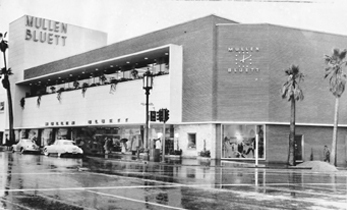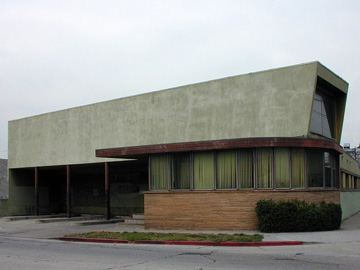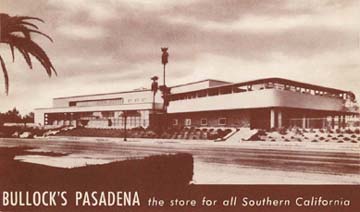
Stiles Clements’ Mullen & Bluett building, 1949, 5570 Wilshire, built in the Late Moderne, a style that typified the optimistic postwar building boom. Note the sexy geometric volumes and eyebrow canopy. Mullen & Bluett is a perfect example of the Miracle Mile’s auto-oriented “linear downtown,†as Reyner Banham put it. Think Wayne McAllister’s Bob’s Big Boy in Burbank or Wurdeman & Becket’s Bullocks Pasadena. Legacy Partners of Irvine are razing this building and replacing it with a 197-unit apartment/retail thingy that resembles the lowest common denominator of faux-Miami Deco. (Their next project is enveloping the Art Deco Desmond’s tower in nine stories of apartments.) I say go check M&B’s roman brick & flagstone façade and copper beveled display windows while you still can-it’s too late to admire Clements’ 1936 masterpiece of streamline KEHE building, recently demolished by LAUSD, or his equally unbelievable Coulter’s, once across the street.
This is the Bach Auricon Inc. building, 1954, 6900 block of Romaine at 900 block of Mansfield:

BA are incredibly important in the history of filmmaking, especially as regards TV newsreels and documentaries. Auricon was a semi-self-blimped single system that recorded optical or magnetic sound on film, allowing our cinema-verité pioneers to shoot with a lightweight, maneuverable, quiet camera. Logos for Modulite, Cine-Voice, Datasync and Filmagnetic are still on this building; rumors of its impending demolition abound. This is correct, original Old Hollywood in the way a thousand trips along our current Hollywood Boulevard can never be.
(A photographic addtion, in reference to the posted comment:)

Bullock’s was designed by Wurdeman and Becket in ’47. They started designing uber-icons of LA with the Pan-Pacific in ’35. Also from their camp came General Petroleum (’46) and the Prudential Insurance (’48) until, with Wurdeman’s death in ’49, Becket struck out on his own. There’s Parker Center (’53), Capitol Records (’54), the Beverly Hilton (’55), the Santa Monica Civic (’58), the Cinerama Dome (’63), the Music Center (’64) — said “Googie” author Alan Hess, “Welton Becket’s greatest buildings are as much a part of Los Angeles as Christopher Wren’s are of London. They cannot be divided fromt the way we see or think of LA.”
While Clements’ M&B is going down (his ca. 1955 Zandt Carpet in Hollywood was recently demo’d) other Late Modernes are about. Crawford’s 1947 Sears in Santa Monica is getting landmarked. And check out Paul Williams’ 1958 County Couthouse for a Late-Late Moderne (and they say we never mention African-Americans on this blog).
Bullock’s has undergone a recent renovation. Looks nice, go check it out. The eyebrow on M&B — essentially a projecting canopy attached to an existing wall, there more as a horizontalizing design element than for any efficacy related to wind or rain — shares the zeitgeist with Bullock’s, but the Bullock’s canopy is more “serious,” if you will.
https://patrickprescott.com/archives/001410.php